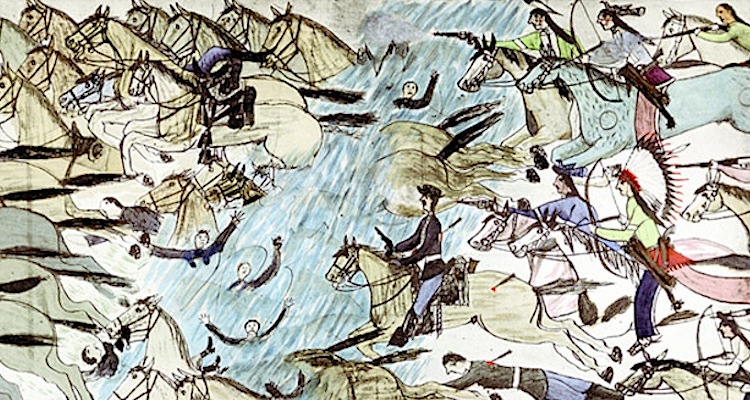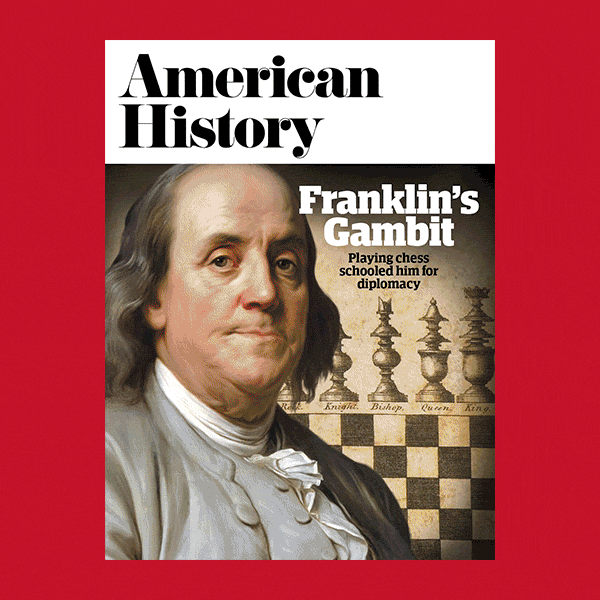On June 25, 1876, one of the Indians facing Custer and his 7th Cavalry was 34-year-old Northern Cheyenne Two Moon. A minor chief of the tribe’s Kit Fox Society, he had been a warrior from the age of 13 and had briefly served as a government scout. After rushing to face the threat from Major Marcus A. Reno’s detachment to the south, Two Moon turned north to fight off Custer’s units. Some 22 years after the Battle of the Little Bighorn, Two Moon told his story of the fight to short-story writer and novelist Hamlin Garland. The following edited excerpt of his account comes from Garland’s report of that interview as it was published in the September 1898 issue of McClure’s Magazine. While some of Two Moon’s numbers are probably exaggerated, his tale does give a feeling for the chaos of the event.
I went to water my horses at a creek, and washed them off with cool water, then took a swim myself. I came back to the camp afoot. When I got near my lodge, I looked…towards Sitting Bull’s camp. I saw a great dust rising. It looked like a whirlwind. Soon [a] Sioux horseman came rushing into camp shouting “Soldier come! Plenty white soldiers.”
Outside, far up the valley, I heard a battle cry, “Hay-ay, Hayay!” I heard shooting, too, this way [clapping his hands very fast]. I couldn’t see any Indians. Everybody was getting horses and saddles. After I had caught my horse, a Sioux warrior came again and said, “Many soldiers are coming.”
I rode swiftly toward Sitting Bull’s camp. There I saw the white soldiers fighting in a line [Reno’s men]. Indians covered the flat. They began to drive the soldiers all mixed up—Sioux, then soldiers, then more Sioux, and all shooting. The air was full of smoke and dust. I saw the soldiers fall back and drop into the river-bed like buffalo fleeing. They had no time to look for a crossing. The Sioux chased them up the hill, where they met more soldiers in wagons. And then messengers came saying more soldiers were going to kill the women, and the Sioux turned back. Chief Gall was there fighting. Crazy Horse also.
I then rode toward my camp, and stopped squaws from carrying off lodges. While I was sitting on my horse I saw flags come up over the hill to the east like that [he raised his finger-tips]. Then the soldiers rose all at once, all on horses, like this [he put his fingers behind each other to indicate that Custer appeared marching in columns of fours]. They formed into three branches [squadrons] with a little ways between. Then a bugle sounded, and they all got off horses, and some soldiers led the horses back over the hill.
Then the Sioux rode up the ridge on all sides, riding very fast. The Cheyenne went up the left way. Then the shooting was quick, quick. Pop—pop—pop very fast. Some of the soldiers were down on their knees, some standing. Officers all in front. The smoke was like a great cloud, and everywhere the Sioux went the dust rose like smoke. We circled all round them— swirling like water round a stone. We shoot, we ride fast, we shoot again. Soldiers drop, and horses fall on them. Soldiers in line drop, but one man rides up and down the line—all the time shouting. He rode a sorrel horse with white face and white forelegs. I don’t know who he was. He was a brave man.
Indians keep swirling round and round, and the soldiers killed only a few. Many soldiers fell. At last all horses killed but five. Once in a while some man would break out and run toward the river, but he would fall. At last about a hundred men and five horsemen stood on the hill all bunched together. All along the bugler kept blowing his commands. He was very brave too. Then a chief was killed. I hear it was Long Hair [Custer], I don’t know; and then five horsemen and the bunch of men, may be so forty, started toward the river. The man on the sorrel horse led them, shouting all the time. He wore [a] buckskin shirt, and had long black hair and mustache. He fought hard with a big knife. His men were all covered with white dust. I couldn’t tell whether they were officers or not. One man all alone ran far down toward the river, then round up over the hill. I thought he was going to escape, but a Sioux fired and hit him in the head. He was the last man. He wore braid on his arms [Sergeant James Butler?].
All the soldiers were now killed, and the bodies were stripped. After that no one could tell which were officers. The bodies were left where they fell. We had no dance that night. We were sorrowful.
Next day four Sioux Chiefs and two Cheyenne and I, Two Moon, went upon the battlefield to count the dead. One man carried a little bundle of sticks. When we came to dead men, we took a little stick and gave it to another man, so we counted the dead. There were 388. There were thirty-nine Sioux and seven Cheyennes killed, and about a hundred wounded.
Some white soldiers were cut with knives, to make sure they were dead; and the war women had mangled some. Most of them were left just where they fell. We came to a man with a big mustache; he lay down the hill towards the river. The Indians did not take his buckskin shirt. The Sioux said, “That is a big chief. That is Long Hair.” I don’t know. I had never seen him. The man on the white-faced horse was the bravest man.
Originally published in the June 2006 issue of American History. To subscribe, click here.






